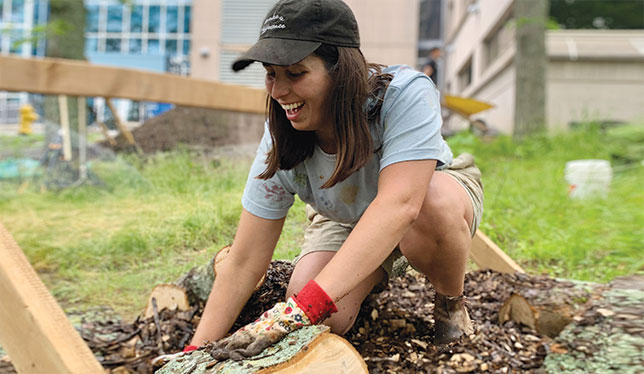As a master of resource and environmental management student at Dalhousie University, Samantha Ceci knows all too well the negative effects of climate change. Though it’s easy to feel despair, Ms. Ceci says it’s important to remember the things within our grasp that we can change. This line of thinking inspired her and some fellow students to plant a hügelkultur garden bed on the university’s Studley campus to highlight the benefits of this sustainable planting method that encourages biodiversity.
“I try to be really cognizant of the climate anxiety that so many of us are faced with, and constantly being under this narrative that we need to do more,” Ms. Ceci says. “My intention with this project was to celebrate something that we can do.”

Derived from the German term for “hill” or “mound,” a hügelkultur bed is a type of raised garden built with uneven topography to accommodate a variety of species that have different height elevation, water and soil drainage requirements. This is a key part of what makes a hügelkultur bed sustainable. These beds are also often constructed using materials found in the immediate area, like fallen branches, wood and bark, which will biodegrade and integrate into the bed over time.
“The species that you plant in the bed may be site specific, but creating that soil layer itself can really be done anywhere,” Ms. Ceci says. “The big consideration when you’re creating the bed is using native materials — so not dragging in tree branches or leaves from out of site to avoid spreading invasive species.”
Having various types of plants in the bed creates a “pollinator-friendly habitat” that can help tackle a problem aggravated by climate change known as phenological mismatch. This happens when plants that pollinators, such as bees or butterflies, need flower earlier than normal, before the pollinators arrive. Ms. Ceci likens this phenomenon to waking up too late and finding out that the breakfast buffet is closing. Since a hügelkultur bed accommodates species that flower at different times, it can help combat the issue.
“We’re constantly learning about new ways to contribute positively towards the climate crisis, and this was just a great opportunity to apply that knowledge,” Ms. Ceci says. “Studying about different impacts and different contributions to a solution is one thing, but actually being able to contribute is a pretty cool feeling.”